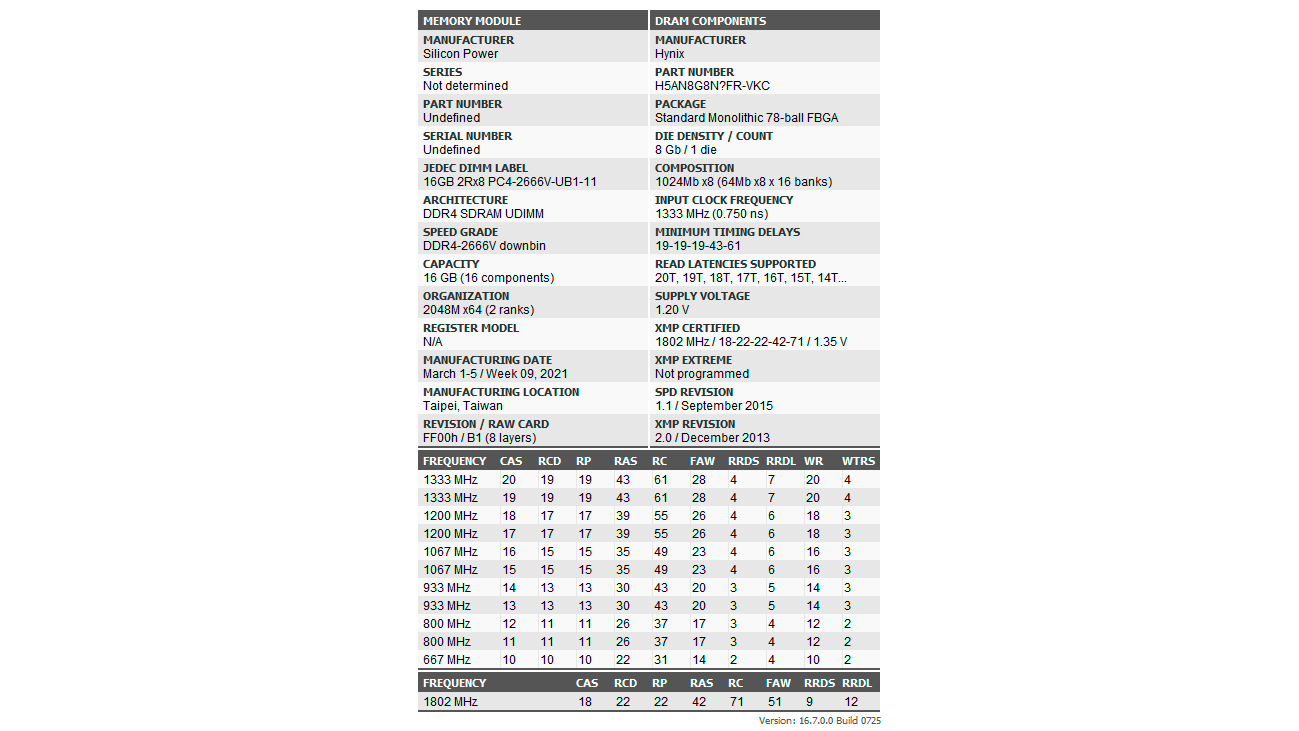Tom's Hardware Verdict
The Xpower Zenith RGB DDR4-3600 C18 is a non-intrusive memory kit with average looks, but it has a lot of performance under the hood.
Pros
- +
Strong XMP performance
- +
Short heat spreader
- +
RGB doesn't require proprietary software
Cons
- -
Gaps in the RGB lighting
- -
Limited U.S. availability
Why you can trust Tom's Hardware
The Xpower Zenith RGB will probably be familiar to you if you've already seen Silicon Power's non-RGB version — they're carbon copies of each other. The only difference is that the Xpower Zenith RGB features an RGB diffuser with five addressable RGB LEDs. Other than that, the memory module still comes equipped with a low-profile aluminum heat spreader dipped in an iron-grey color.
Many tests have shown that a setup with four memory ranks is the ideal configuration to maximize the performance on Intel and AMD processors. A few years ago, that translated to a 32GB (2x16GB) memory kit, as 16GB memory modules are typically dual-rank. The emergence of higher-density integrated circuits (ICs) changed that, though. So with single-rank 16GB memory modules becoming more common, it's hard to tell the difference nowadays if a 32GB memory kit has single-rank or dual-rank modules. Rest assured, though, that the Xpower Zenith RGB has a dual-rank design that is superior to single-rank competitors.



Despite its RGB lighting, the Xpower Zenith RGB checks in at the same height of 38.5mm (1.52 inches) as the vanilla version. One of the downsides of the Zenith RGB's implementation is that it has spaces between the RGB LEDs, which may look visually unappealing. Silicon Power doesn't include any software to control the Xpower Zenith RGB's illumination, but that isn't an issue since the memory is compatible with Asus Aura Sync, Gigabyte RGB Fusion, MSI Mystic Light Sync, and ASRock Polychrome Sync.
Silicon Power manufactures its Zenith RGB 32B (2x16GB) memory modules on an eight-layer PCB and sticks with a traditional dual-rank design. They feature Hynix ICs, although Thaiphoon Burner wasn't able to decipher the exact model. The H5AN8G8N?FR-VKC are potentially C-die ICs.
The memory defaults to DDR4-2133 and 19-19-19-43 timings when the system posts for the first time. Flipping the XMP switch will quickly bring the memory up to DDR4-3600 and the timings to 18-22-22-42. The Zenith RGB requires 1.35V to hit the advertised frequency. For more on timings and frequency considerations, see our PC Memory 101 feature, as well as our How to Shop for RAM story.
Comparison Hardware
| Memory Kit | Part Number | Capacity | Data Rate | Primary Timings | Voltage | Warranty |
|---|---|---|---|---|---|---|
| GeIL Orion AMD Edition | GAOR432GB4266C18ADC | 2 x 16GB | DDR4-4266 (XMP) | 18-24-24-44 (2T) | 1.45 Volts | Lifetime |
| G.Skill Trident Z Royal | F4-4000C17D-32GTRGB | 2 x 16GB | DDR4-4000 (XMP) | 17-18-18-38 (2T) | 1.40 Volts | Lifetime |
| Crucial Ballistix Max RGB | BLM2K16G40C18U4BL | 2 x 16GB | DDR4-4000 (XMP) | 18-19-19-39 (2T) | 1.35 Volts | Lifetime |
| Patriot Viper Elite II | PVE2432G400C0K | 2 x 16GB | DDR4-4000 (XMP) | 20-26-26-46 (2T) | 1.40 Volts | Lifetime |
| G.Skill Trident Z Neo | F4-3600C16D-32GTZN | 2 x 16GB | DDR4-3600 (XMP) | 16-16-16-36 (2T) | 1.35 Volts | Lifetime |
| Mushkin Redline Lumina | MLA4C360GKKP16GX2 | 2 x 16GB | DDR4-3600 (XMP) | 16-19-19-39 (2T) | 1.40 volts | Lifetime |
| Klevv Bolt XR | KD4AGU880-36A180C | 2 x 16GB | DDR4-3600 (XMP) | 18-22-22-42 (2T) | 1.35 Volts | Lifetime |
| Silicon Power Xpower Zenith RGB | SP032GXLZU360BDD | 2 x 16GB | DDR4-3600 (XMP) | 18-22-22-42 (2T) | 1.35 Volts | Lifetime |
| Lexar Hades | LD4BU016G-R3600UDLH | 2 x 16GB | DDR4-3600 (XMP) | 18-22-22-42 (2T) | 1.35 Volts | Lifetime |
| Patriot Viper Steel RGB | PVSR432G360C0K | 2 x 16GB | DDR4-3600 (XMP) | 20-26-26-46 (2T) | 1.35 Volts | Lifetime |


The Intel system employs the Intel Core i9-10900K and Asus ROG Maximus XII Apex, which operates on the 0901 firmware. On the opposite side, the AMD system consists of the AMD Ryzen 9 5900X and the Asus ROG Crosshair VIII Dark Hero. The latter is on the 3501 firmware. The MSI GeForce RTX 2080 Ti Gaming Trio makes sure there are no bottlenecks in our gaming RAM benchmarks,
| Header Cell - Column 0 | Intel System | AMD System |
|---|---|---|
| Processor | Intel Core i9-10900K | AMD Ryzen 9 5900X |
| Motherboard | Asus ROG Maximus XII Apex | Asus ROG Crosshair VIII Dark Hero |
| Graphics Card | MSI GeForce RTX 2080 Ti Gaming X Trio | MSI GeForce RTX 2080 Ti Gaming X Trio |
| Storage | Crucial MX500 500GB, 2TB | Crucial MX500 500GB, 2TB |
| Cooling | Corsair Hydro H115i Pro | Corsair Hydro H115i Pro |
| Power Supply | Corsair RM650x 650W | Corsair RM650x 650W |
| Case | Streacom BC1 | Streacom BC1 |
Intel Performance







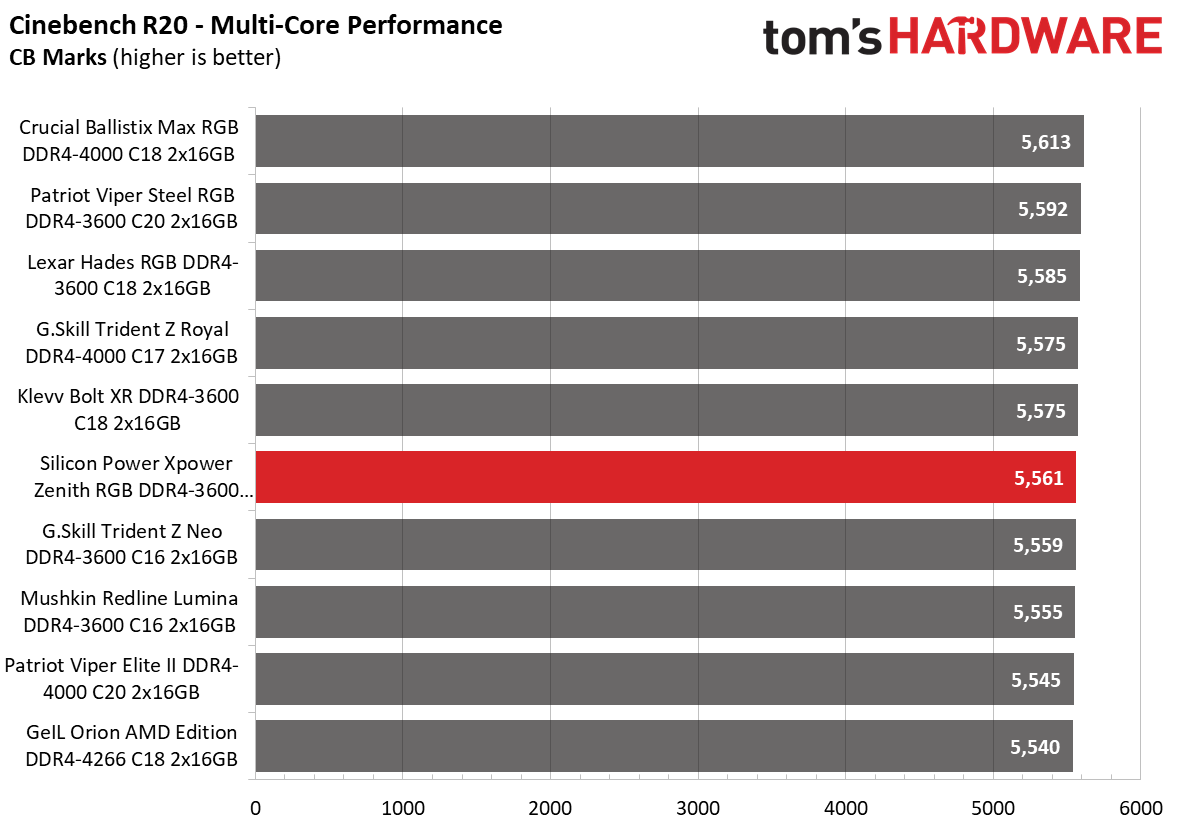


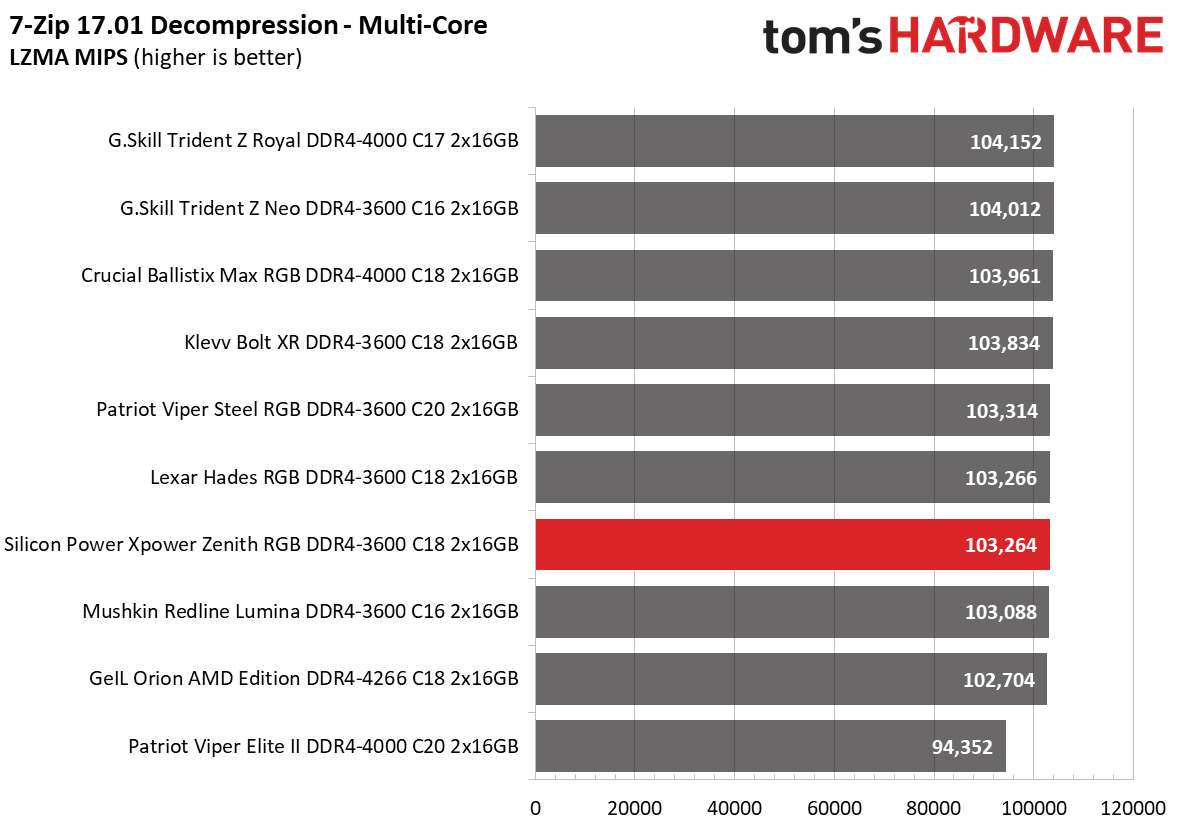





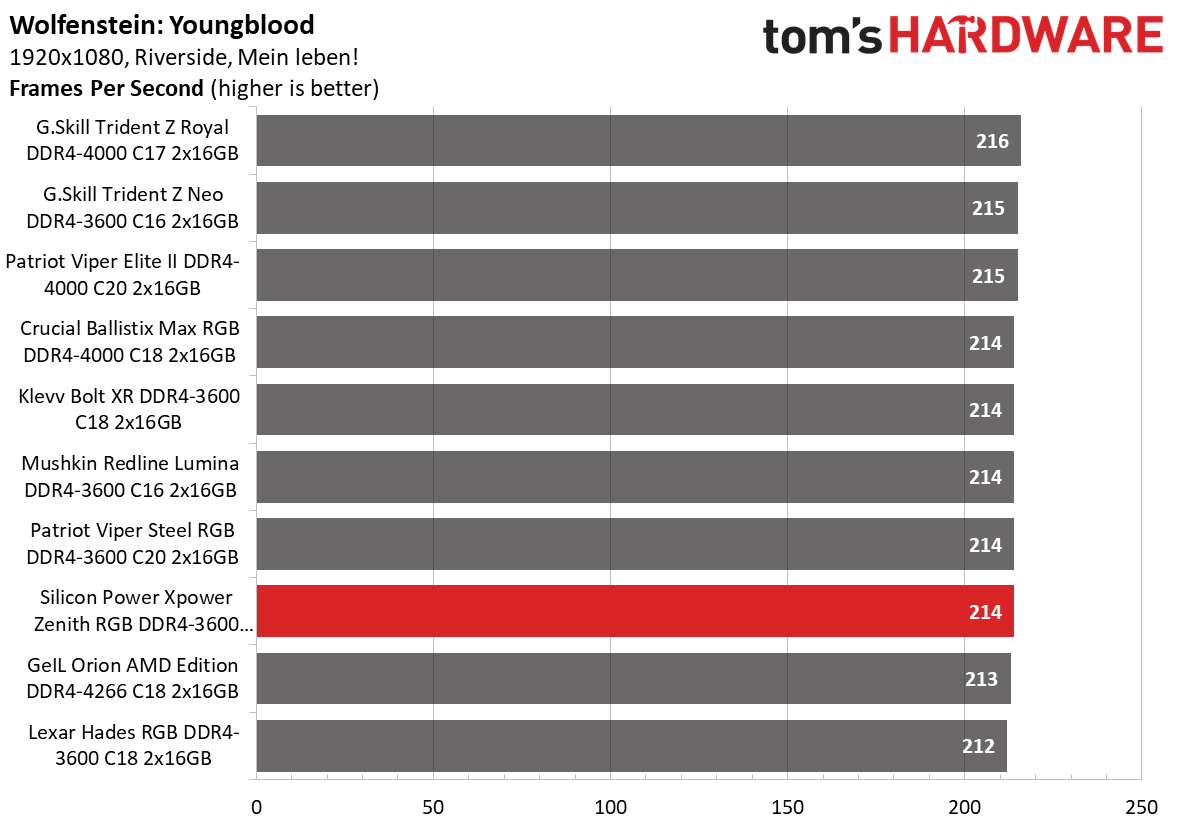


The Xpower Zenith RGB ranked fourth in overall application performance. The memory kit outshined its single-rank rivals, such as the Viper Elite DDR4-4000 C20 and the Orion AMD Edition DDR4-4266 C18. It just goes to show the benefit of a dual-rank memory kit over a single-rank one.
Get Tom's Hardware's best news and in-depth reviews, straight to your inbox.
AMD Performance








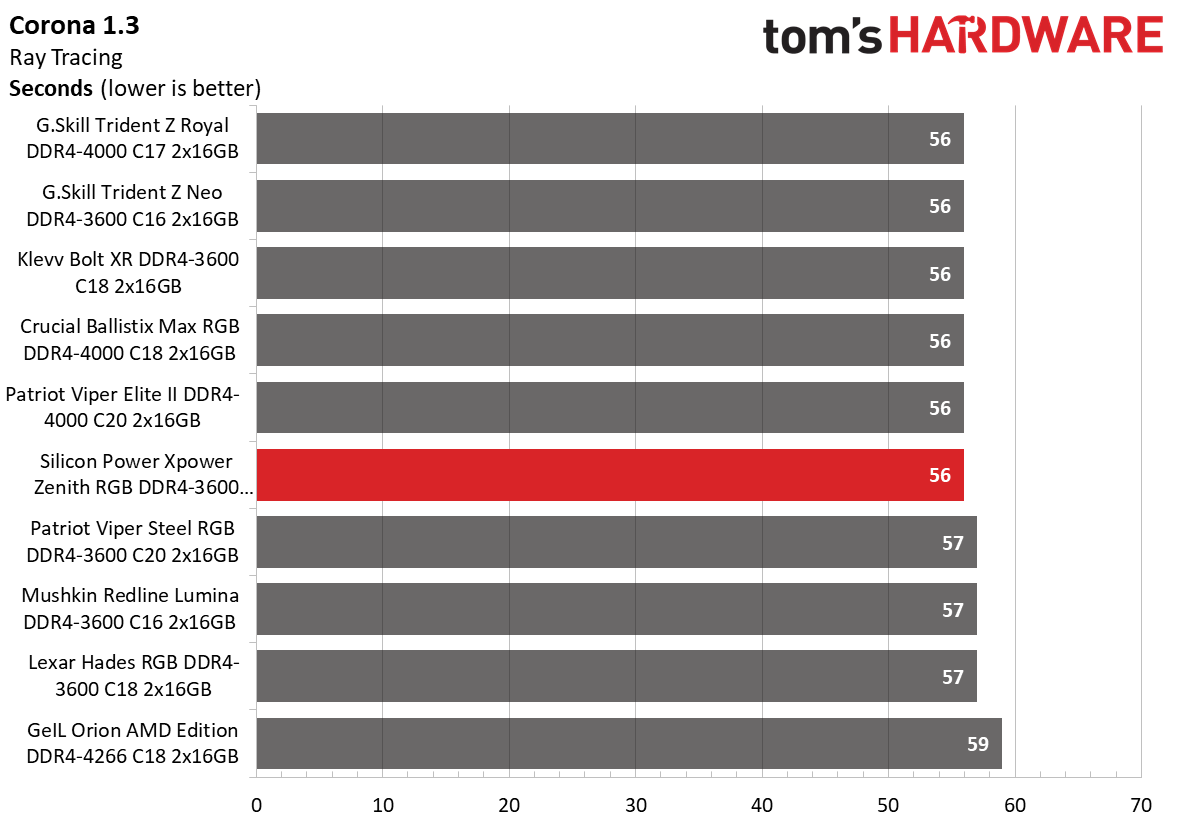






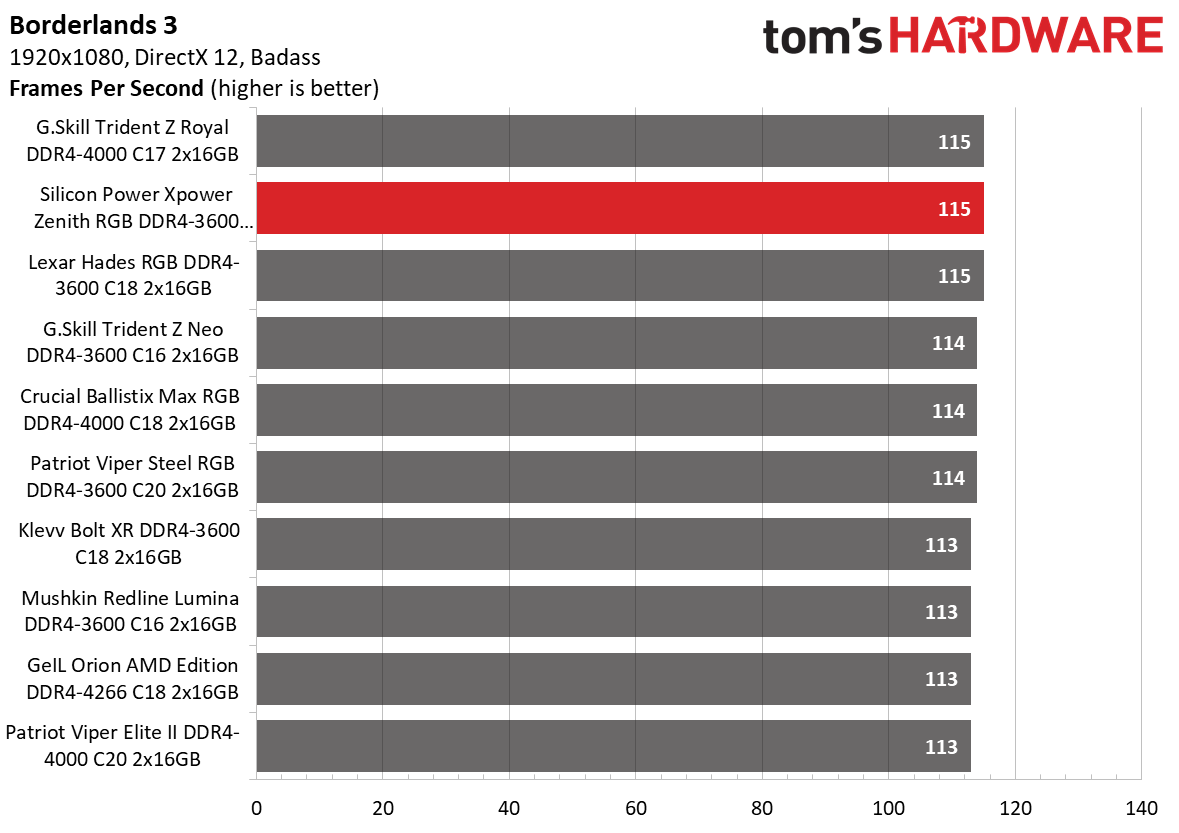

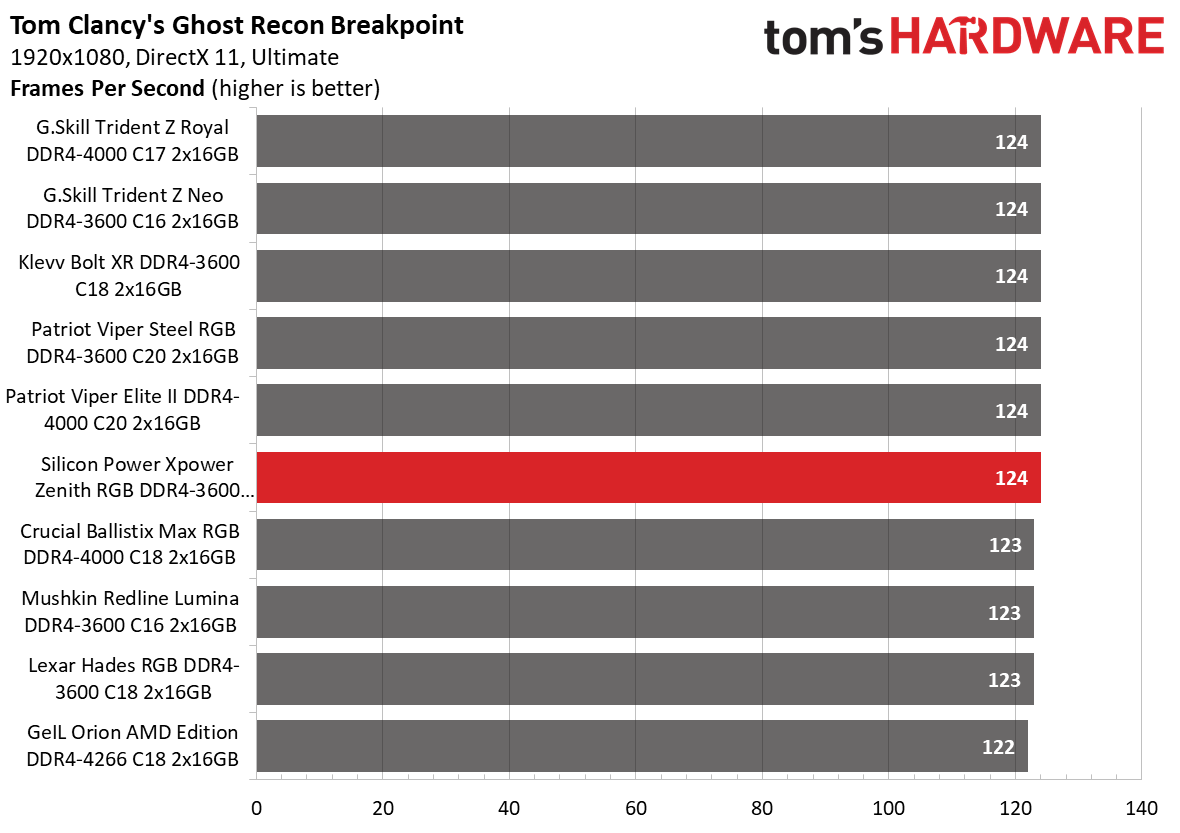
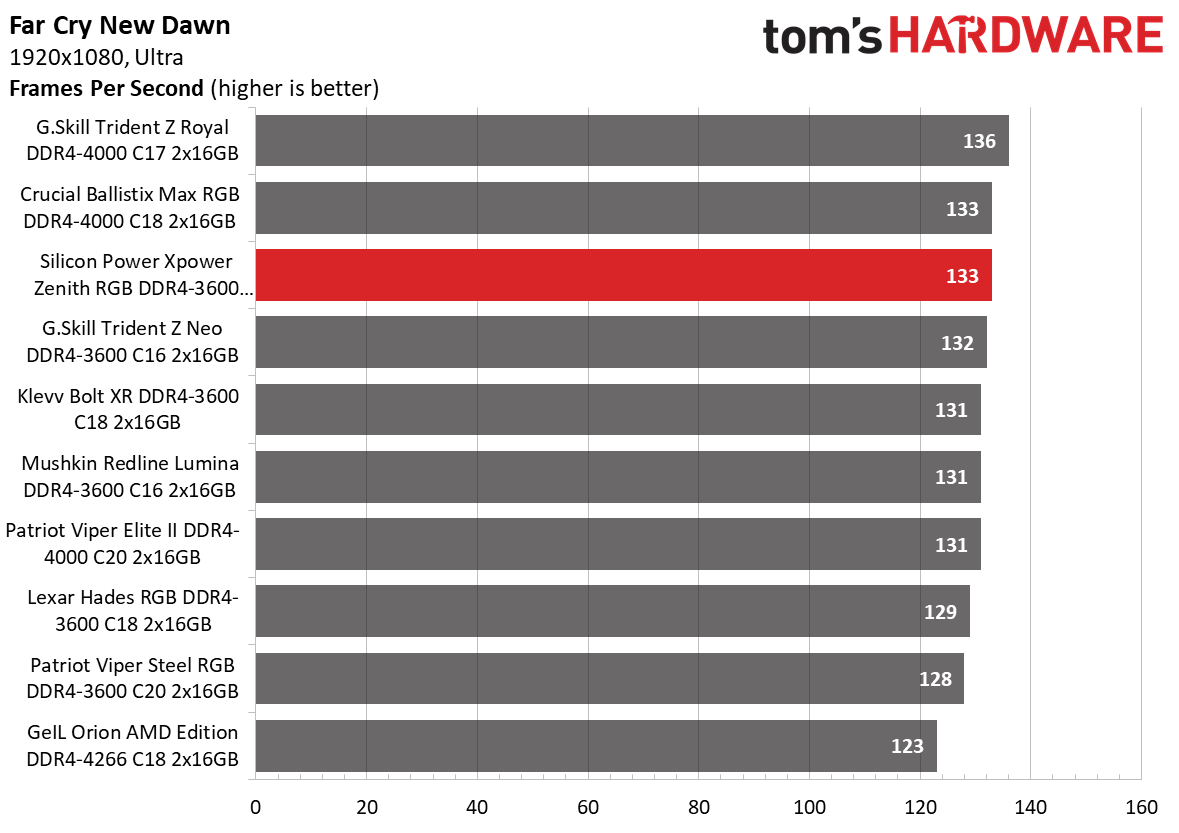
The Zenith RGB kit performed even better on the AMD platform, finishing third in our cumulative application chart. The Xpower Zenith RGB delivered its best performance in Cinebench R20.
Overclocking and Latency Tuning



Overclocking the Xpower Zenith RGB memory kit to DDR4-4100 was very easy. Bumping the DRAM voltage from 1.35V to 1.45V was all it took to stabilize the memory at the aforementioned data rate. We didn't have to make any changes to the memory's primary timings, either.
Lowest Stable Timings
| Memory Kit | DDR4-3600 (1.45V) | DDR4-3800 (1.45V) | DDR4-4100 (1.45V) | DDR4-4133 (1.45V) | DDR4-4200 (1.45V) |
|---|---|---|---|---|---|
| G.Skill Trident Z Neo DDR4-3600 C16 | 13-14-14-35 (2T) | N/A | N/A | N/A | 19-19-19-39 (2T) |
| Klevv Bolt XR DDR4-3600 C18 | 16-19-19-39 (2T) | N/A | N/A | 18-22-22-42 (2T) | N/A |
| Mushkin Redline Lumina DDR4-3600 C16 | 16-17-17-37 (2T) | N/A | 17-19-19-39 (2T) | N/A | N/A |
| Silicon Power Xpower Zenith RGB DDR4-3600 C18 | 17-19-19-39 (2T) | N/A | 18-22-22-42 (2T) | N/A | N/A |
| Patriot Viper Steel RGB DDR4-3600 C20 | 16-20-20-40 (2T) | 17-26-26-46 (2T) | N/A | N/A | N/A |
| Lexar Hades RGB DDR4-3600 DDR4-3600 C18 | 17-20-20-40 (2T) | N/A | N/A | N/A | N/A |
Knowing that Silicon Power used Hynix ICs in the Xpower Zenith RGB memory kit, we kept our expectations in check. With the DRAM voltage increased to 1.45V, we managed to lower the timings down to 17-19-19-39 from the default 18-22-22-42. It wasn't the most amazing result, but it fell in line within the margins of what Hynix ICs have to offer.
Bottom Line
The Xpower Zenith RGB DDR4-3600 C18 may not be the best-looking memory kit on the market, but what it lacks in aesthetics, it makes up for in performance. Silicon Power's memory kit is testimony to the kind of performance that a dual-rank memory kit brings to the table. The Xpower Zenith RGB DDR4-3600 C18 easily outperformed its single-rank rivals, including the memory kits that look faster on paper, like the Redline Lumina DDR4-3600 C16 or the Ballistix Max RGB DDR4-4000 C18.
Silicon Power's Xpower Zenith memory kits are available on Amazon. The Xpower Zenith RGB DDR4-3600 C18, in particular, has a $203 MSRP, placing its pricing in the middle of the plethora of DDR4-3600 memory kits. Unfortunately, the Xpower Zenith RGB DDR4-3600 C18 hasn't made its way to the U.S. retailer yet, which is a shame since it's a very attractive option for consumers that want a decent DDR4-3600 memory kit at the 32GB capacity.

Zhiye Liu is a news editor, memory reviewer, and SSD tester at Tom’s Hardware. Although he loves everything that’s hardware, he has a soft spot for CPUs, GPUs, and RAM.
